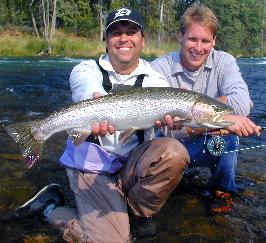|
| |
 The Rogue
River stands alone in the
Northwest when it comes to the possibility of catching a steelhead on a fly rod.
This stream presents the best likelihood for beginner and veteran alike to hook
a crazy sea-going rainbow even when compared to the imposing likes of fabled
steelhead waters as the Deschutes
and North Umpqua. Rogue River steelhead are "grabby", considering these
are fish that do not need to eat during their spawning migration.
The Rogue
River stands alone in the
Northwest when it comes to the possibility of catching a steelhead on a fly rod.
This stream presents the best likelihood for beginner and veteran alike to hook
a crazy sea-going rainbow even when compared to the imposing likes of fabled
steelhead waters as the Deschutes
and North Umpqua. Rogue River steelhead are "grabby", considering these
are fish that do not need to eat during their spawning migration.
This fishery is so exceptional it is here that our Rogue
River steelhead fishing guides choose to spend their personal fishing time late
summer and fall, even though the steelhead of the famous Umpqua River to the
north and the Klamath River to the south are only a couple of hours away.
There are two components to the
summer/fall run of Rogue River steelhead: the familiar one-salt (one year at
sea) and two-salt (two years at sea) fish, and, secondly, the precocious,
aggressive "half-pounder" steelhead for which the river is most famous.
The half-pounders are a peculiar race that spend
only several months in the saltwater bay at Gold Beach before making a "U" turn,
returning to freshwater as smaller counterparts of the one- and two-salt
full-size steelhead. Add resident rainbow trout, sea-run cutthroat,
chinook salmon, and silver salmon to the seasonal river mix, and an angler has a large "buffet" of exciting fishing possibilities.
With almost 150 river miles from
Lost Creek Dam to the Rogue River's mouth, knowing where to fish at any give
time of year is imperative. Though there are are steelhead in the Rogue
virtually every month of the year, August through November present the best
water conditions com bined
with fishable numbers of willing Rogue River steelhead. bined
with fishable numbers of willing Rogue River steelhead.
As for steelhead fly fishing methods, dry flies, wet flies,
and nymphs can all be effective. If a skilled angler takes into account
the water temperature, time of day and the right piece of water, it's a real
possibility to catch Rogue River steelhead using all three methods in a single
summer or early fall day. Nymphing proves effective year around, even when
the water is too cold to interest fish in a skated dry or standard wet fly
presentation. ( A good Rogue River steelhead fly fishing guide MUST know
how to fish nymphs, and be well-versed in effective Rogue River
steelhead flies.)
Because at any given time an individual steelhead may not be
in a biting mood, a good strategy is to thoroughly cover a given piece of
water then move on. However, if you know the run to be a good one, with a high
probability that it holds numerous steelhead, it may be worth your time to
switch flies or presentations and cover the water a second time before moving
on.
One of the most important decisions your competent Rogue
River steelhead guide will make is knowing when to pull anchor and float to the next likely fishing hole.
When to linger --- changing flies or tactics ---, and when to run. Knowing
"when to hold 'em, and when to fold 'em."
If I might indulge in a gambling analogy . . . Steelhead
fly fishing is like repeatedly pulling the handle on a slot machine: the more good
casts you make in likely waters, the greater the likelihood you will "hit the
jackpot". To increase your odds of hooking a steelhead cover the water
quickly and completely, then get to the next downstream casino. Keep
pulling that slot machine handle.
More
Rogue River steelhead fishing guide trip details
(click here) Book a
Rogue River steelhead fly fishing guide trip
(click here)
|